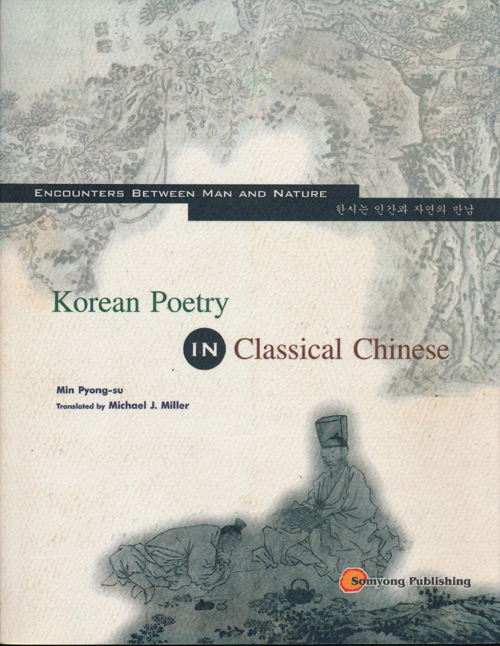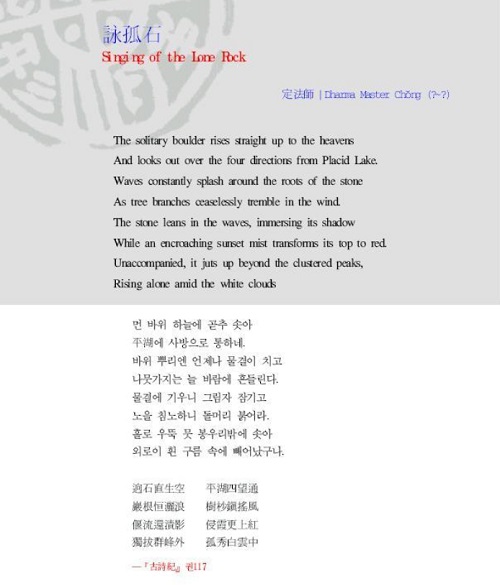Korea and China have a long history of mutual exchanges. Geographical adjacency has made it possible, and far easier, for the two cultures to interact with each other much more than with other groups.
The two Asian nations actively engaged in literary exchanges, too, evidenced by a broad collection of hansi, Korean poetry written in classical Chinese, that has been passed down throughout the generations.

Such Sino-Korean poems are pre-modern works of literature written in classical Chinese characters. Despite being a bit different from classical Chinese poetry from China, the Korean poems do maintain many things in common in terms of style and form. As classical Chinese was the most common written language throughout ancient times, and, more specifically, maintained its dominance even after Hangeul, the Korean alphabet, was invented and up until modern times, lots of hansi poems have been handed down from generation to generation.
To bring to a global audience some of Korea’s most outstanding hansi poems, the Daesan Foundation has published “Korean Poetry in Classical Chinese,” a collection of 79 ancient poems that mainly talk about nature and human existence, with each work being carefully translated into poetic English.
The collection, co-translated by Korean literature Professor Min Pyong-su of Seoul National University (SNU) and Michael J. Miller, an SNU graduate in Chinese language and literature, features a wide range of such poems, dating back to the late Silla Kingdom (57 B.C.-A.D. 935) and the early Goryeo Dynasty (918-1392) all the way through to the late Joseon Dynasty (1392-1910).

The volume begins with “Singing of the Lone Rock," or "詠孤石,” a poem written by Dharma Master Chong, a monk from the Goguryeo Kingdom (37 B.C.–A.D. 668).
廻石直生空 平湖四望通
岩根恒灑浪 樹杪鎭搖風
偃流還漬影 侵霞更上紅
獨拔群峯外 孤秀白雲中
The solitary boulder rises straight up to the heavens
And looks out over the four directions from Placid Lake.
Waves constantly splash around the roots of the stone
As tree branches ceaselessly tremble in the wind.
The stone leans in the waves, immersing its shadow
While an encroaching sunset mist transforms its top to red.
Unaccompanied, it juts up beyond the clustered peaks,
Rising alone amid the white clouds.
Each piece is presented first in English, then in Korean and finally in the original classical Chinese, followed by comments and footnotes in English. This method enables readers to compare the translations with the original and to get a better understanding of each work.
By Sohn JiAe
Korea.net Staff Writer
jiae5853@korea.kr
The two Asian nations actively engaged in literary exchanges, too, evidenced by a broad collection of hansi, Korean poetry written in classical Chinese, that has been passed down throughout the generations.

'Korean Poetry in Classical Chinese' features 79 ancient Korean poems written in classical Chinese.
Such Sino-Korean poems are pre-modern works of literature written in classical Chinese characters. Despite being a bit different from classical Chinese poetry from China, the Korean poems do maintain many things in common in terms of style and form. As classical Chinese was the most common written language throughout ancient times, and, more specifically, maintained its dominance even after Hangeul, the Korean alphabet, was invented and up until modern times, lots of hansi poems have been handed down from generation to generation.
To bring to a global audience some of Korea’s most outstanding hansi poems, the Daesan Foundation has published “Korean Poetry in Classical Chinese,” a collection of 79 ancient poems that mainly talk about nature and human existence, with each work being carefully translated into poetic English.
The collection, co-translated by Korean literature Professor Min Pyong-su of Seoul National University (SNU) and Michael J. Miller, an SNU graduate in Chinese language and literature, features a wide range of such poems, dating back to the late Silla Kingdom (57 B.C.-A.D. 935) and the early Goryeo Dynasty (918-1392) all the way through to the late Joseon Dynasty (1392-1910).

Dharma Master Chong’s “Singing of the Lone Rock," or "詠孤石."
The volume begins with “Singing of the Lone Rock," or "詠孤石,” a poem written by Dharma Master Chong, a monk from the Goguryeo Kingdom (37 B.C.–A.D. 668).
廻石直生空 平湖四望通
岩根恒灑浪 樹杪鎭搖風
偃流還漬影 侵霞更上紅
獨拔群峯外 孤秀白雲中
The solitary boulder rises straight up to the heavens
And looks out over the four directions from Placid Lake.
Waves constantly splash around the roots of the stone
As tree branches ceaselessly tremble in the wind.
The stone leans in the waves, immersing its shadow
While an encroaching sunset mist transforms its top to red.
Unaccompanied, it juts up beyond the clustered peaks,
Rising alone amid the white clouds.
Each piece is presented first in English, then in Korean and finally in the original classical Chinese, followed by comments and footnotes in English. This method enables readers to compare the translations with the original and to get a better understanding of each work.
By Sohn JiAe
Korea.net Staff Writer
jiae5853@korea.kr